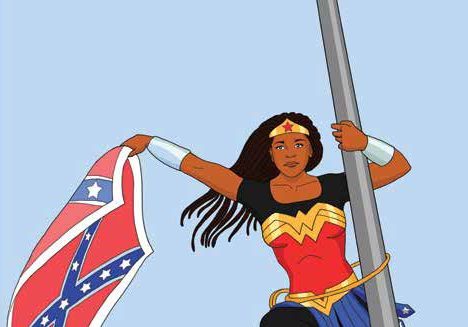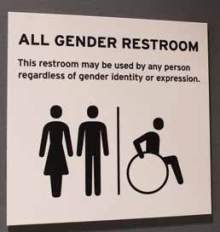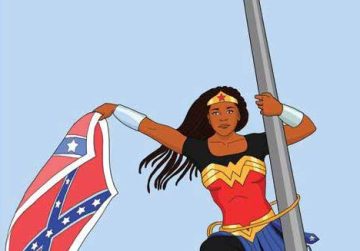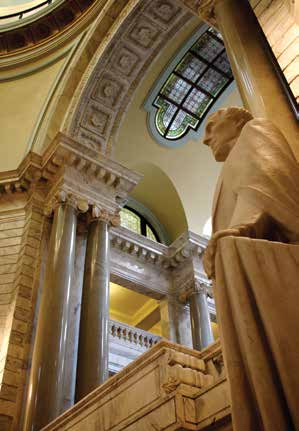
“Take down the flag. Take it down now. Put it in a museum. Inscribe beneath it the years 1861–2015.” — Ta-Nehisi Coates
The past year has been marked by protests across the globe as communities grapple with issues of race, identity, culture, history and symbolism. People are climbing out of the boxes long used to define and control society—male/female; straight/gay; white/black/yellow—demanding control over their identities and how these identities are represented. These issues have dogged the US since the nation’s founding, but now activists are using the power of social media to ensure they are heard. Objects—powerful symbols of individuals, groups, history and society as a whole—have become explosive points of contention. And museums, as public stewards of our collective history, find themselves enmeshed in the struggle over representation, identity and material culture.
Western society is beginning to acknowledge the complexities of human identity—including race, sexual orientation and gender. Government notoriously lags behind social change, with the US Census perpetually playing catch-up, changing how it collects data to support the way people categorize (or resist categorizing) themselves. The Census Bureau first allowed people to identify as more than one race in the year 2000. In the following decade, the number of people choosing this option doubled, reaching 1.8 million by 2010. New parents are more likely to identify their babies as belonging to more than one race, and grown children are more likely to change
the identity assigned by their parents and self-identify as multiracial. Paradoxically, by splitting the categories of race and culture, changes to the Census may slow the apparent rate at which the US approaches “majority minority” status, as many Hispanics choose to self-identify as white.
We are also beginning to accept, once we stop forcing people into binary categories, that sexual orientation and gender are both continuums. Sixteen percent of Americans identify themselves as neither fully hetero nor homosexual, but somewhere in between. And some people are able to recognize that their gender doesn’t synch with their genes or morphology as early as age three. Our social and legal systems, as well as our built environment, are slowly adapting to reflect these complexities. (In 2014 Facebook presented users with 58 gender options, as well as three pronouns.) While many universities struggle with how to accommodate students who transition in college (particularly at single-sex universities), the University of Vermont has officially recognized a third gender: neutral. Society pushes off many serious life decisions until a child “comes of age,” but that’s not an option for parents and children planning for gender reassignment surgery. When is it too early or too late? Norway is considering a law that would allow children as young as 7 to legally change their gender, but forbid sex-reassignment surgery until they are 18.



But accepting fluid boundaries can heighten concerns over representation and control. Are there limits to the right to claim one’s own identity? Rachel Dolezal was pilloried in social media and the press for self-identifying as black when her parents and peers experienced her originally as white. Dolezal has repeatedly expressed that she acted on a deeply felt sense of internal identity. But critics accuse her—and other whites presenting themselves as black—of dabbling in an identity they can abandon if it becomes inconvenient. Identity is a matter of personal history as well. Some feminists were furious with the public accolades showered on Caitlyn Jenner. As Elinor Burkett wrote, “People who haven’t lived their whole lives as women…shouldn’t get to define us…. [B]eing a woman means having accrued certain experiences, endured certain indignities and relished certain courtesies in a culture that reacted to you as one.” Burkett believes that Jenner’s right to identify as female doesn’t transcend an experience mostly lived as male. The landscape is no less fraught when it comes to groups rather than individuals.
The landscape is no less fraught when it comes to groups rather than individuals. Who has standing to speak on behalf of a community? While supporters of the “Change the Mascot” campaign pressure the NFL team based in Washington, DC, to stop using a racial slur (“Redskins”) as its name, some Native Americans rallied in support of the team’s moniker. Further complicating matters, culture isn’t just a matter of parentage; it is also a matter of heritage. Does an individual have to be raised in a culture in order to represent it? The Navajo Nation recently wrestled with whether to allow a tribal member not fluent in Navajo to hold public office, and eventually decided to amend the election requirements. The rise of social media has changed the dynamics of these conversations, both accelerating
Are there limits to the right to claim one’s own identity? Who has standing to speak on behalf of a community?
The rise of social media has changed the dynamics of these conversations, both accelerating change and amplifying conflict. Twitter is the ultimate megaphone, empowering protesters to take their concerns directly to a massive public, unfiltered by the mainstream press. This amplification can create its own issues regarding representation—a tweet storm may not distinguish between consensus within a community and outlying positions. Social media, especially anonymous platforms, often encourages people to be their worst, unfiltered selves. A student sit-in at Colgate University, for example, was met by a torrent of abusive postings on Yik Yak, exposing a strain of racism that might never have surfaced in civil dialogue (although the protest organizer noted this may be good thing, since at least now the college can’t pretend those attitudes don’t exist on campus).
The increasingly fractal nature of identity can make it hard to moderate competing voices that each claim to speak on behalf of a community. Last summer the Museum of Fine Arts, Boston was the target of a protest instigated by a simple (some would say simplistic) selfie opportunity: encouraging visitors to don a replica kimono and pose in front of Monet’s La Japonaise. The protests, in turn, sparked counterprotests, including people of Japanese heritage wearing their own kimonos, and prompted the deputy consul general of Japan in Boston to speak up on behalf of the museum. One Japanese American blogger noted that “the groups most offended by Kimono Wednesdays appear to be non-Japanese Asian Americans and white allies,” and criticized the media as treating “all Asian Americans as a homogeneous group.”
Issues of identity and representation not only play out on the individual and corporate level, but also in the public sphere as we grapple with tangible reminders of a painful past. In the US, calls to #TakeDownTheFlag led to the removal of the Confederate battle flag, first from the grounds of the South Carolina Courthouse, and then in a cascade from Capitol Hill in Montgomery, Alabama, to the University of Mississippi and even St. Paul’s Episcopal Church (known as the “Cathedral of the Confederacy”) in Richmond, Virginia. A statue of Confederate president Jefferson Davis was removed from the campus of University of Texas, Austin, and some students at the University of Missouri are trying to oust Thomas Jefferson. At Yale, student protesters are pressuring the university to rename Calhoun residential college, as John C. Calhoun was a strong advocate of slavery. South Africa is confronting similar issues in response to calls that statues of Cecil #RhodesMustFall, and former Soviet bloc countries wrestle with the choice of saving or destroying statues of Lenin (or, more subversively, reshaping them into Darth Vader, as did one artist in Ukraine).
Now the question becomes not whether to take down a flag or a statue, but where to draw boundaries. Do public monuments perpetuate oppression, or remind us of the history we need to redress? The person or people who defaced the monument to Calhoun in Charleston were drawing a line—geographically and intellectually—from his racist views, across Marion Square, to the recent murders of nine worshipers at the Emanuel African Methodist Episcopal Church. But as many commentators are pointing out, if we erase tangible reminders of our past, how will we understand how we got where we are?

What This Means for Society
If our communities proactively address social justice issues, we may negotiate cultural/social transformation in productive and equitable ways. Conversely, if society resists change until an explosive tipping point is reached, the resulting violence often ends up damaging the very neighborhoods that seek legitimate redress. For example, research suggests that cities damaged by riots following Dr. Martin Luther King Jr.‘s assassination witnessed a nearly 10 percent decrease in the income of black families and higher unemployment among young men.
Our colleges and university communities—often the ignition points for significant social reform—tread a difficult line when they seek to balance respect and inclusion with intellectual inquiry. In the past year, while the University of Missouri and Yale (among others) have struggled to respond to calls for reform, both college authorities and protesters have stumbled. The moral authority of administrators has been undermined by missteps and tone-deaf statements, while the cause of activists has been tarnished by accusations of bullying and suppression of freedom of speech.
As a society, we need to create an environment (physical and regulatory) that treats people with respect, which includes not presuming they fit into neat categories. As with the civil rights and disability rights movements, restrooms are once again on the front line of social change. While many cities and schools negotiate the reinvention of the restroom (how many, who gets to use them, signage), opponents of Houston’s Equal Rights Ordinance sank the initiative in fall 2015 by inflaming fears of sexual predators lurking in the public loo. (This anxiety is an echo of the past: Phyllis Schlaffly invoked the same bogeyman to argue against passage of the Equal Rights Amendment.) By contrast, cities at the forefront of equal access (Seattle, Philadelphia, Berkeley, Santa Fe, Austin, Dallas) have passed ordinances requiring all gender restrooms.
What This Means for Museums
Whether they seek an active role or not, museums are being called on to act as cultural hazmat teams. In story after story about taking down Confederate battle flags, or removing statues and commemorative plaques, the writer or speaker concludes with a call to “put it in a museum.” What does this signify? Do people want museums to serve as explosion-proof vaults for volatile social issues? Or do they want museums to bury offensive objects in collections storage, out of sight and out of mind? Or (optimistically), do people trust museums to foster productive debate, dialogue and reconciliation?
With regard to a museum’s own collections, what does “cultural appropriation” mean (beyond the legal issues of cultural patrimony)? When is it wise, necessary or desirable to tell the backstory of colonialism and oppression that lies behind so many collections (whether fine art, decorative art, historic artifacts or natural history specimens), and when is it okay to have a less-fraught point of access?

Are there subjects that can only be appropriately addressed by people or groups that represent, genetically and historically, the topic in question? In December 2015, John Cummings opened the Whitney Plantation in Louisiana as what he characterizes as America’s first museum dedicated to telling the story of slavery. Cummings is white, and some (even before the opening of the museum) slammed the project as “an example of continued profiteering off the suffering of black people,” while others hailed him as a modern-day John Brown—a white man battling racism and oppression.
Museum Examples
In 2014 the Minnesota Historical Society (MNHS) created a Department of Inclusion and Community Engagement (DICE) to “guide internal and external strategies across all historic sites and museums to embed inclusive practices in our work to ensure the diversity of the state is reflected in all MNHS activities, including collections, programs, staffing, volunteers, historic preservation and governance.” As Chris Taylor explained in a series of posts on the Incluseum blog (see Additional Resources), one of the goals of the department is to “recognize the expertise within our various diverse communities and use our resources to amplify voices of diverse communities through collaboration and co-creation.” While the Society had a long history of reaching out to diverse constituencies, they created DICE to integrate and elevate these efforts.
In the wake of the murders of nine African American worshippers at the Emanuel African Methodist Episcopal Church in Charleston, South Carolina, on June 17, 2015, Fort Sumter National Monument removed the Confederate flags flying over the site. The National Park Service stated that some Confederate flags and banners (but not the most controversial battle flag) would be returned later in the year to a less visible location. “As a focal point of Charleston Harbor, it is important that the only flag seen flying atop Fort Sumter National Monument is the current United States flag,” said Superintendent Tim Stone. “The historical flag display will be in the fort so visitors can learn about the fort’s history and the history of the flags that flew here.” Predictably, this middle course angered people who felt the flags should not be displayed at all, and also those who felt they never should have been removed.
“Investigating Identity,” one of MoMA’s learning themes, uses the museum’s collections to explore how people perceive and express themselves. As the program description notes, “factors and conditions that an individual is born with—such as ethnic heritage, sex, or one’s body—often play a role in defining one’s identity.” Through this constructivist approach to learning, students are encouraged to interpret art through the lens of their own experience.
As it prepared to move to Lower Manhattan, the Whitney Museum of American Art hosted a discussion about what it means for a museum to be a “safe and welcoming space,” including the provision of gender-neutral restrooms. Signage in the new building now reads “All Gender Restroom.” The American Folk Art Museum and the Utah Museum of Fine Arts provide all gender (or gender neutral) restrooms for visitors as well.
In recent decades, museums have tried to compensate for the overall lack of racial and cultural diversity among their own staff through the use of advisors and advisory boards. Given the contested nature of identity, it may be increasingly challenging to choose groups and individuals to “represent” the interests of whole cultures, races, etc. Can any individual or group speak for the whole? What validates the approval such groups offer the museum, and who has standing to challenge their input?
Museums Might Want to…
- Take a fresh look at their own environment and the overt and subtle signals they might send about the categories in which they place visitors, potentially signaling who is welcome and not welcome. Adopting the philosophy that “everyone deserves to pee in peace” may be as simple as altering signage, or it may require modifying, adapting or renovating available facilities…and not just the restrooms.Create productive ways to navigate controversy
- Create productive ways to navigate controversy within the museum’s own sphere—anticipating and welcoming hard conversations—before the need arises. Recognize that no group is homogeneous, and no one person or set of people inoculates the museum against criticism. There will probably be a diversity of opinion within any
given group, and all it takes is a Twitter hashtag to launch a small protest into the national news. - Realize that people will experience the museum in the context of their own identity and concerns. Guided by its mission, a museum may focus on the aesthetic or scientific meaning of an object—but others may view these collections through the lens of culture and history. How can museums validate and acknowledge these perspectives?
- Decide whether and how to play a role in decommissioning or relocating culturally explosive icons in their states/cities/communities. This may include confronting offensive symbols in a museum’s own historic properties and sites, and memorials recognizing a museum’s founder or donors. In some communities, it may mean wading into issues that have the potential to alienate segments of the museum’s visitors and supporters.
- Consider the opportunity (many consider it an obligation) to play a role in community dialogue: defusing, healing, rebuilding. This might take the form of the museum’s usual core activities: collecting and exhibiting artifacts and oral histories that document conflict and calls for social change. It may extend to being intermediaries, bringing together people of good will to find common ground on contentious issues. Additional ResourcesMuseum Hue (www.facebook.com/Museumhue, @museumhue)
Additional Resources
Museum Hue (www.facebook.com/Museumhue, @museumhue) is a community of practice that advocates for educators, culture workers and museum professionals. It is dedicated to “tackling issues at the intersection of identity, culture, art and community” and “champions equity, agency, diversity and inclusion within cultural institutions.”
The Incluseum (http://incluseum.com) based in Seattle is dedicated to the vision that “inclusion become an integral priority for all museums and flourish through supportive community relationships.” Their resources include an essay by nikhil trivedi on defining oppression in museums. Another resource from trivedi is an Ignite talk for Museum Computer Network 2015—“Towards an Anti-Oppression Museum”— in which he offers some suggestions for beginning hard conversations.
In a series of posts on the blog Japanese-American in Boston, Keiko K. parses the complexities of who has standing to protest in the Museum of Fine Arts, Boston, Kimono Wednesdays controversy.








